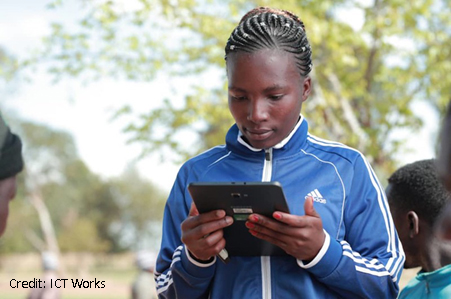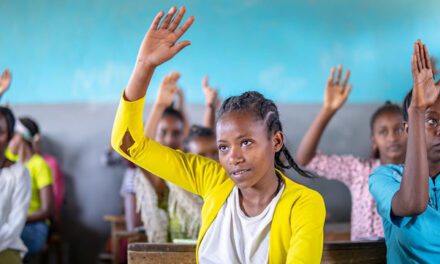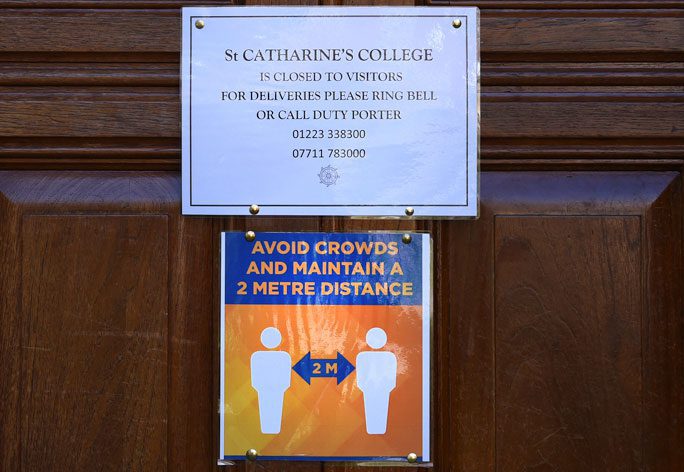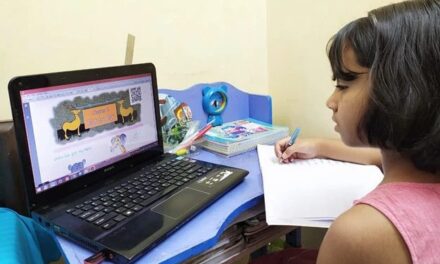This blog was written by Mary Burns, Education Development Center, and Peter Orne, a Boston-based communications consultant and former Editorial Director of the Wireless Internet Institute. With thanks to Noopur Jhunjhunwala, Monitoring, Evaluation, and Partnerships Coordinator at United Nations Women India MCO, for serving as a reviewer. This article was originally published on ICT Works on 10 June 2020.
COVID-19 is a global health disaster, a global economic disaster, and a global education disaster. As we write this, 90% of the world’s students – from pre-primary to higher education – are out of school, and millions lack access to instruction.
UNESCO reports that 826 million students have no access to a household computer and 706 million have no internet at home. The majority of these students live in Sub-Saharan Africa. Around the world, poor students in wealthy countries and students in poor countries on the wrong side of the digital divide, are finding their education cut short.
It did not have to be this way. Although no one predicted this particular pandemic, the world suffered enough of them – at least 11 since World War I – to know that another was coming. Since the turn of this century, political and economic upheavals, conflict and displacement, terrorism, extreme weather, and other events have all pushed students out of school and disrupted education.
Despite the frequency of global, national, and local emergencies, many governments have failed to plan for this new normal. While the best time to invest in digital infrastructure, digital resources, and training to ensure educational continuity was before the pandemic, the urgent need to bring the classroom to students everywhere is now upon us.
Online Learning Is a Utility, Not a Luxury
To extend classroom learning to the home, teachers and students need a computer connected to high-speed Internet. Without the two, they cannot engage in real-time online learning. For too long in education development, however, digital technology has been viewed as a private versus a public good, a nice-to-have versus a must-have, a luxury versus a right – especially in Sub-Saharan Africa.
Governments, technology companies, and international donors still address the digital divide with a shrug of fatalism: Digital infrastructure is something rich countries get but poor ones cannot afford and, by extension, should not expect.
For decades, radio and television have served as worthy distance education technologies, and they should remain in any national distance education plan, particularly for use with young learners who may not yet be ready for online learning. They are being used now when and where Internet technology is unavailable or unreliable. In regions where there is Internet connectivity, MOOCs provide self-paced pre-recorded curricula that may be accessed in shared settings even at low bandwidths.
4 Ways to Build Back Better – Online
The pandemic has exposed the fragility of the status quo ante of our views about the importance of extending the classroom through online learning to ensure educational continuity in time of crisis.
The lack of digital infrastructure and resources doesn’t mean that poorer students don’t want or can’t benefit from virtual classrooms. If education is a basic right, and crises like COVID-19 become long-term or recurrent, how do we ensure that students have technology access to ensure this right going forward?
- Push for Universal Broadband Access
GrameenPhone founder Iqbal Quadir’s catchphrase is now a familiar one: Connectivity is productivity. Affordable and widely available high-speed Internet has tremendous spill-over effects.
- It promotes growth, equality, and efficiency in all sectors—business, health, and education.
- It allows disadvantaged populations—women, minorities, persons with disabilities—to participate more easily in the labor market, as e-commerce entrepreneurs, in online work, or in business-process outsourcing.
The Internet is far too important to be viewed as a private good or a luxury controlled by private companies. For it to make a real difference in lives and societies, it must be widely available for free or at low cost.
Many entities acknowledge the importance of universal broadband access to education. UNESCO’s Incheon Declaration for Education 2030, adopted in 2015 by more than 120 country ministers and delegations, multilateral and bilateral organizations, and civil-society, private-sector, teacher, and youth representatives, calls for “the provision of quality distance learning in tertiary education, with appropriate financing and use of technology, including the Internet, massive open online courses and other modalities that meet accepted quality standards to improve access.”
Article 9 (“Accessibility”) in the 2006 U.N. Convention on the Rights of Persons with Disabilities calls for “access for persons with disabilities to new information and communications technologies and systems, including the Internet.” Numerous jurisdictions—South Korea, Estonia, Uruguay, Singapore, Shanghai—have essentially put these beliefs into practice by providing Internet access to all learners while countries like Rwanda, Kenya and South Africa, despite barriers, have shown commitment to and made progress toward affordable broadband for all.
As much as we need global agreement on the right course of action, we need the public-private commitments to make broadband Internet access permanent. In the United States, more than 700 companies have signed the Federal Communications Commission’s Keep Americans Connected Pledge, which casts connectivity as a universal, moral, and equitable undertaking.
A similar pledge at the global level would commit governments, multilateral and bilateral lending agencies, and technology and telecommunications actors to a set of actions, policies, and programs that support universal broadband access for unserved and underserved people and communities. It would promote regulations and statutes that ensure that these actions and policies are enacted.
- Focus on the Last Mile Challenge
Much progress in connectivity has been made over the last two decades. Indeed, most countries enjoy “first mile” access—connectivity to the country itself and to major population areas. The problem remains the “middle mile” and overwhelmingly, and formidably, the “last mile.”
Only public and private investment at scale can provide last mile access to the poorest, most remote areas. In many places, building out last mile access means piggybacking on or repurposing existing infrastructure and services:
- converting unlicensed television and radio spectrum to deliver Internet access;
- releasing additional and emergency spectrum;
- pushing ISP and mobile operators to lower the cost of their service;
- establishing and enforcing regulations and statutes that create an overall enabling environment for investment in wireless communication infrastructure and services.
Without these and other actions, the virtual classroom will remain out of reach for millions of students.
- Privilege Online Learning Policies
Many national and local jurisdictions are using their emergency powers to support educational continuity through online learning during the pandemic. The government of South Africa and numerous technology and telecommunication vendors have entered into “zero-rating” agreements for educational content and services exempting education data from counting against a user’s data cap or accruing extra charges.
The City of Los Angeles has provided emergency funding and is collaborating with a local ISP to distribute technology and Internet access to 600,000 students. In February, the Chinese government launched a national cloud platform that makes digital learning resources available free of charge to 50 million students.
One day the pandemic will end, but policy actions like these should be made permanent so students and teachers in poor and remote areas can take advantage of online learning whenever they need it.
This can be supplemented by policies that provide tax credits to telecommunication companies to extend infrastructure into poor and remote communities; and directing all technology funding and donations from the private-sector and donors into a ring-fenced trust to be used for educational technology initiatives (similar to South Africa’s National Education Collaboration Trust).
- Build Out Virtual Classrooms
Real learning in virtual environments will succeed only if we also invest in digital content and instructional know-how. Even in wealthy countries, many school districts that quickly enabled distance learning have found that they lack the funding, digital resources, and policies to support online instruction, and have struggling with all of these issues amidst this pandemic.
The situation is worse in poorer countries: In many parts of the world, where schools have technology, they use pirated versions of software they cannot afford, or students access digital content in languages they cannot understand. Thus, the market-driven nature of digital content development perpetuates a longstanding equity issue.
Teachers who already have comfort with in-person teaching must also become online learners themselves as they discover what elements and instructional techniques work best in the virtual classroom.
We need to:
- Provide principals, teachers, students, and parents with technology training
- Help teachers learn how to teach with technology both in class and remotely;
- Build the capacity of school principals to manage digital resources and provide instructional leadership;
- Help education officials within the system support digital inclusion and quality instruction via technology.
Beyond Business as Usual
Unfortunately, the current modus operandi of technology provision, infrastructure investment, and foreign aid often do not support any of these actions. Many governments have left broadband Internet access to the private sector, outsourcing policy and planning to their favorite technology companies.
Many more bilateral donors have eschewed digital infrastructure altogether and address educational inequities and access through disjointed project-based approaches that often lack the necessary investment, resources, and time to promote depth, spread and eventually scale.
Enabling quality online learning demands commitment and coordination at the highest levels of a host of partners—telecommunication companies and ISP providers, media companies, governments, multilateral and bilateral aid agencies, technology providers—working together to attain the same purpose.
It will demand a mix of investments from increased international funding to public-private partnerships to tapping into and increasing Universal Service Funds, and debt cancellation so heavily indebted nations can free up financial resources to begin to undertake digital investments.
It will require coherent, developed, integrated, and funded national educational technology plans with high degrees of oversight and accountability. Above all, it will require political will and a recognition that though this demands enormous amounts of planning, money, time, and expertise, the benefits are essential to educational continuity in times of disruption.
No More New Divides
There’s much we do not know about the trajectory of the coronavirus and its short- and long-term impacts. We can expect that there will be other crises—potentially worse than this—that will suddenly deprive millions of students of an education.
Across a century, we learned how to provide curricula over radio and television. In little over a decade, we learned how to extend digital learning to students in many secondary and tertiary settings. The pandemic will bring an unprecedented wave of innovation in online learning to all grade levels through COVID-19 Digital Response.
Rather than exacerbate the current digital divide or create altogether new divides, let’s make sure that all of the world’s learners, especially those who suffer the greatest deprivations, can benefit from these advancements.






It is important to make and win this argument